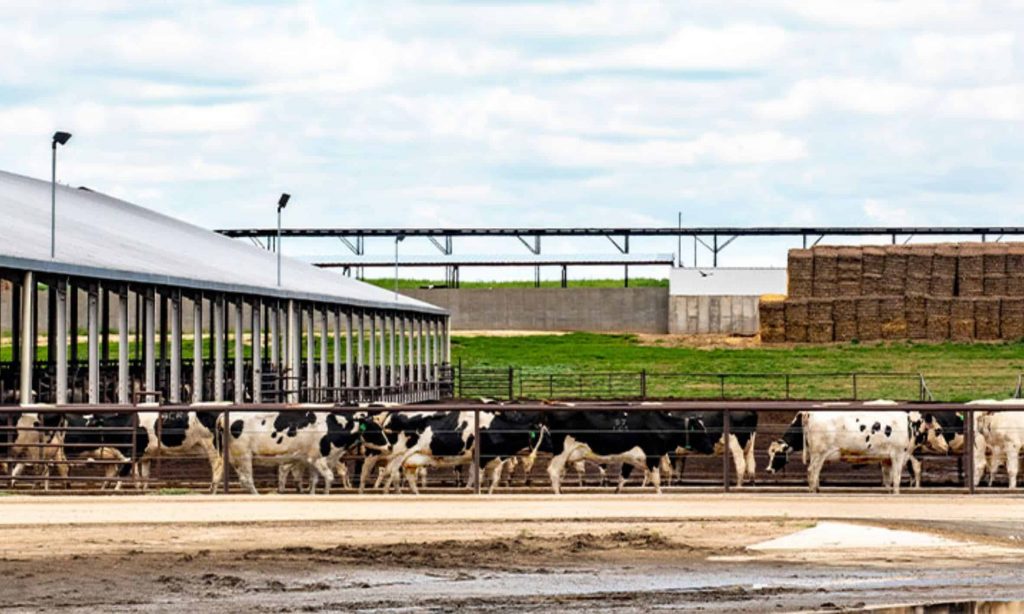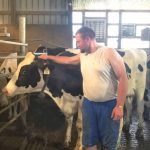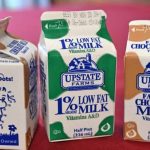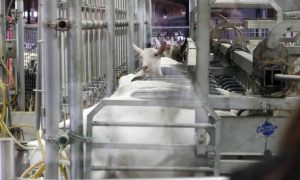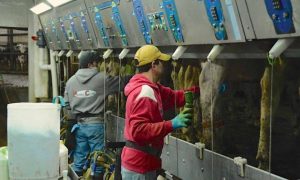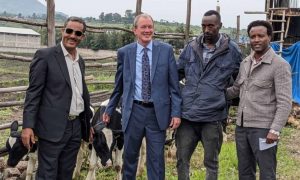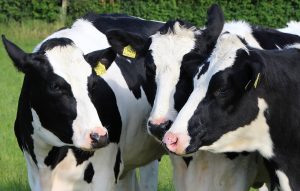
Calmly walking from loafing shed to milking parlor and back again three times every day, the 6,000 Holsteins at Quail Ridge Dairy southeast of Fort Morgan move at their own pace, quietly contributing their milk production talent while the dairy operation hums along.
It’s all powered by cow-inspired planning and a team of 85 people who manage every detail of animal comfort, while maintaining a pleasant, rewarding work environment.
Cow comfort bolsters dairy production
“I’m really into systems and I love efficiency,” says Mary Kraft, who owns and manages Quail Ridge Dairy with her husband, Chris, and son, Stratton. “We are always thinking about animal behavior and how we can capitalize on it to make the animals comfortable.”
The interconnected facility keeps labor to a minimum and avoids bottlenecks. “I can just open a gate and they move into the next pen. I could move every animal in the heifer lot in two hours working alone.”
In the double-50 parallel milking parlor, Kraft leverages the herd instinct. “If cows can see each other, moving in a group and not too fast, they’ll be more comfortable and will let down their milk faster. With 50 cows on a side, if two or three take an extra four or five minutes to milk, that slows down the whole barn.”
Employee comfort is also top of mind. The milking parlor floors are heated to help them stay dry and a center ridge design keeps air flowing into the room and out through the roof for pleasant temperatures without drafts caused by power ventilation. Guards around the cows keep tails and feet a safe distance from the eight-person milking teams, while offering easy access for prep and milking tasks.
Every cow sports a transponder that collects data on milk production, breeding dates and more. A computerized system at each milking station lets milkers send an alert when a cow needs attention. After milking, those cows and others due for drying off are automatically diverted through a shuttle gate to a holding pen for reassignment to the dry cow group or the farm’s hospital facility.
“That technology means we have a no-stress environment,” says Kraft. “I don’t want an environment where cows get injured because we’re doing things too quickly or without thinking. And employees, who are busy with 12 other things, don’t have to remember it all.”
The steady stream of production data also helps her detect when a cow’s milk output is lagging. “Every cow has a unique threshold based on past performance. I know how much milk she gave on every shift since she started milking. Milk per cow per day is what I’m looking for. If she’s going to keep her spot, she needs to produce 10 gallons a day.
“We’re all interested in how big our carbon footprint is — well, your footprint gets bigger when you have a cow that’s not making the milk she should. She’s using resources and not contributing.”

Integrated milk production system
The highly efficient setup means every cow is in and out of the milking parlor in about 10 minutes. “We want to get her back to a healthy, comfortable place where she can chew her cud, eat as much as she wants, have free-choice water and hang out with her buddies,” says Kraft.
Most of the cows’ time is spent in one of the farm’s five airy freestall barns, each holding two groups of 450 cows. They have access to outside lots when fine weather beckons.
With constant movement to and from the milking parlor, the freestall barns are only empty for about 25 minutes at a time. While cows are away, workers tidy the beds and add feed. Every day at 4 a.m., the bunks are scraped clean and fresh feed is added.
The bedding is produced by the farm’s on-site waste management system. An automatic scraper system cleans the freestall barn floors every 45 minutes while the cows are in place, moving so slowly that cows can step over the scraper without startling. A center gutter collects waste and directs it into a screw separator.
Wastewater is used to transport waste, with overflow sent to a lagoon until it’s used to irrigate and fertilize the farm’s 1,500 crop acres, which produce about one-third of its annual forage needs. Irrigation is essential in this arid region, which typically gets 15 inches of moisture per year, although the past year was an exception with 34 inches of snow, a soggy spring and the wettest June on record.
Waste solids are composted in windrows arrayed on a concrete pad. The rows are turned frequently to incorporate oxygen, accelerating the composting process.
“Composting takes six to eight weeks,” says Kraft. “The compost reaches about 140 degrees Fahrenheit, which kills harmful microorganisms. We end up with about one-third of the original volume and the compost makes a soft bed that molds to the cows.”
The farm has experimented with methane digestion, but hasn’t made it part of the waste management system because while methane is produced, the digester can’t produce sterile, dry bedding. “The solids coming out of the digester are wet, so we would have to compost them again,” she explains.
Attention to detail
Animals that need special care or are due to calve hitch a ride on a transport that shuttles between the main dairy and a smaller drylot dairy about a mile down the road. The smaller site includes a milking parlor for 1,500 cows and handles all maternity and veterinary functions.
Employees work there in shifts around the clock, processing 20 to 30 newborn calves per day, helping cows recover from calving and treating any illnesses or injuries. They handle standard veterinary procedures with oversight by a veterinarian.
“We are always looking to prevent problems and we vaccinate like crazy,” says Kraft. “We pay attention to nutrition to avoid problems due to diarrhea, displaced abomasums and things like that.” Monitoring urine pH on dry cows helps determine when ration changes are needed.
Veterinary support is focused on analyzing data to spot problem areas and improve production. “I want my veterinarian to help us figure out if we are producing 1% less milk than we should or have 1% more lame cows than we should.”
Rations are based on flaked corn and a revolving list of byproducts including wheat middlings, DDGS (distillers dried grains with solubles), canola meal and soy hulls. A liquid supplement is used and wet brewers grain helps bind the dry ingredients to reduce wind loss and add palatability.
Agfinity cooperative, based in Loveland, Colo., provides high-energy specialty ingredients that support rumen function and boost cow metabolism, plus provide a feed grain mix for calves.
“The specialty fats we feed make a difference in how the cow metabolizes ingredients,” says Kraft. “We watch body condition scores and pair that with production. That tells me how well she’s utilizing feed. If we’re feeding her to make 100 pounds of milk and she’s only putting in 80 pounds, she’s not using nutrients properly.”

Organic growth
The drylot dairy site was where the Krafts started farming in 1988 with 100 cows, old buildings and worn-out fences. “We’re very organic in our growth, so everything we did here, we grew. If we got 10 extra bucks, it went into the parlor or into buying a cow,” she says.
Their two children were heavily involved in day-to-day operations while living at home. Now Stratton is the third member of the Quail Ridge management team and their daughter, Jordan, is director of agricultural innovation and partnerships at Colorado State University.
Growth wasn’t always easy, Kraft says. “We built this new site in 2007 and the economy fell apart in 2008. Learning how to run our small dairy operation is what got us here. We knew all the parts inside and out and could see the pitfalls and opportunities. That made us good managers and business developers.”
Beyond being an Agfinity owner, Kraft serves on the co-op’s board of directors. The farm sells milk through the Dairy Farmers of America cooperative. “I totally believe in cooperatives. Together, we can do what we can’t do individually.”
Her many leadership roles include chairing the Dairy MAX board, serving on a Colorado State University sustainability advisory board, being past president of the Colorado Livestock Association and helping the Food and Agriculture Organization of the United Nations promote the importance of milk.
“I’m very community-minded. I want to put something back in the community bucket,” she adds. “That’s how communities thrive and not just survive.” Kraft brings that service mindset and passion for efficiency and quality to her role at Quail Ridge Dairy every day.
“About 90% of what we do here is answering key questions,” she adds. “‘What resources do we have? How do we deploy them? What do we want to do with the result?’
“As a manager, you’re looking at all the possible combinations and deciding what makes sense for your location, the genetics you can get, the dollars available because of the milk price, etc. When you do a good job year after year, making tiny changes, it’s hard to make giant leaps, but you have steady improvement.”
Management finesse
Improving efficiency is a game of inches. Mary Kraft, co-owner of Quail Ridge Dairy, Fort Morgan, Colo., offers a few insights:
Optimize genetics
To reduce calving difficulty, speed genetic improvement and leverage profit opportunities, the farm uses sexed semen on first-calf heifers to produce female calves and breeds older cows to Angus bulls, selling the crossbred bull calves into a branded beef program.
“We don’t keep offspring from a third- or fourth-lactation cow because, frankly, those genetics are old. I want her replacement to be better than she is.”
Ensure immunity
New calves get colostrum collected from fresh cows to ensure they ingest vital maternal antibodies and to control costs. Colostrum is pasteurized in small batches, then refrigerated in bottles. About 15 minutes before feeding, the bottles are dropped into a warm water bath that gently agitates them to help the colostrum reach the perfect temperature to activate but not denature colostral antibodies.
“I’m a total believer in pasteurization.” Although it takes time, “When your herd is this size, you’re going to throw away a lot of milk from fresh cows, which seems really dumb. Colostrum is super high in fat and helps bulletproof calves.”
Give employees the “why”
“I want them to make the same decision I would make if I were there. That can only happen when they understand the concept. Since most of our employees didn’t have access to that information before they got here, we create bespoke education for them, including having a veterinarian come out to talk about pneumonia, how to handle vaccines, the appropriate time to wean calves or cleanliness.”
Learn from others
“We belong to a dairy tour group, so we get to see other people’s facilities and ask, ‘Why are you doing this?’ That transparency and trading knowledge makes us all better managers.”
